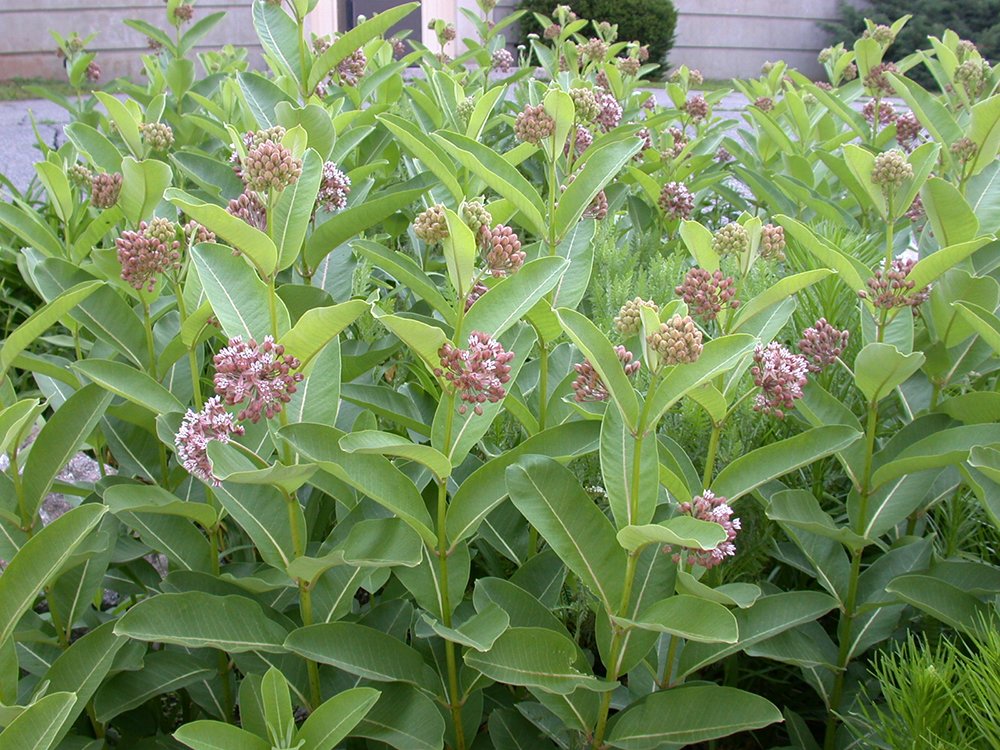 Image 1 of 5
Image 1 of 5

 Image 2 of 5
Image 2 of 5

 Image 3 of 5
Image 3 of 5

 Image 4 of 5
Image 4 of 5

 Image 5 of 5
Image 5 of 5






Common Milkweed
Asclepias syriaca
Type: Perennial
Source: Native
Bloom Period: Summer
Color: White/Pink
Soils: Dry to Medium Soil Moisture
Sun: Full Sun
Height: 3’ - 6’
Common Milkweed is a 3' to 6' tall native perennial with globular heads of lavender to rose flowers. It can grow in dry, shallow, or rocky soils as well as more moist fertile soils, is drought tolerant, and prefers full sun sites. Although perhaps too aggressive for borders, this plant is widely used in butterfly gardens, wildflower meadows, and prairie plant areas. The flowers are showy and fragrant. Common Milkweed is especially valuable as a pollinator conservation species and is a primary host plant for Monarch butterflies. This milkweed was an important fiber source for Native Americans and they had a large variety of medicinal uses for the plant.
While producing a beautiful flower, the ecological importance of common milkweed far outweighs its aesthetic contributions. Asclepias syriaca is a key host for at least six insects: red milkweed beetle (Tetraopes tetrophtalmus), large milkweed bug (Oncopeltus fasciatus), milkweed leaf beetle (Labidomera clivicollis), small milkweed bug (Lygaeus kalmii), a species of weevil (Rhyssomatus lineaticollis), and the monarch butterfly (Danaus plexippus). Considerable recent press has been given to the role of common milkweed in the lifecycle of the monarch butterfly.
Asclepias syriaca
Type: Perennial
Source: Native
Bloom Period: Summer
Color: White/Pink
Soils: Dry to Medium Soil Moisture
Sun: Full Sun
Height: 3’ - 6’
Common Milkweed is a 3' to 6' tall native perennial with globular heads of lavender to rose flowers. It can grow in dry, shallow, or rocky soils as well as more moist fertile soils, is drought tolerant, and prefers full sun sites. Although perhaps too aggressive for borders, this plant is widely used in butterfly gardens, wildflower meadows, and prairie plant areas. The flowers are showy and fragrant. Common Milkweed is especially valuable as a pollinator conservation species and is a primary host plant for Monarch butterflies. This milkweed was an important fiber source for Native Americans and they had a large variety of medicinal uses for the plant.
While producing a beautiful flower, the ecological importance of common milkweed far outweighs its aesthetic contributions. Asclepias syriaca is a key host for at least six insects: red milkweed beetle (Tetraopes tetrophtalmus), large milkweed bug (Oncopeltus fasciatus), milkweed leaf beetle (Labidomera clivicollis), small milkweed bug (Lygaeus kalmii), a species of weevil (Rhyssomatus lineaticollis), and the monarch butterfly (Danaus plexippus). Considerable recent press has been given to the role of common milkweed in the lifecycle of the monarch butterfly.
Asclepias syriaca
Type: Perennial
Source: Native
Bloom Period: Summer
Color: White/Pink
Soils: Dry to Medium Soil Moisture
Sun: Full Sun
Height: 3’ - 6’
Common Milkweed is a 3' to 6' tall native perennial with globular heads of lavender to rose flowers. It can grow in dry, shallow, or rocky soils as well as more moist fertile soils, is drought tolerant, and prefers full sun sites. Although perhaps too aggressive for borders, this plant is widely used in butterfly gardens, wildflower meadows, and prairie plant areas. The flowers are showy and fragrant. Common Milkweed is especially valuable as a pollinator conservation species and is a primary host plant for Monarch butterflies. This milkweed was an important fiber source for Native Americans and they had a large variety of medicinal uses for the plant.
While producing a beautiful flower, the ecological importance of common milkweed far outweighs its aesthetic contributions. Asclepias syriaca is a key host for at least six insects: red milkweed beetle (Tetraopes tetrophtalmus), large milkweed bug (Oncopeltus fasciatus), milkweed leaf beetle (Labidomera clivicollis), small milkweed bug (Lygaeus kalmii), a species of weevil (Rhyssomatus lineaticollis), and the monarch butterfly (Danaus plexippus). Considerable recent press has been given to the role of common milkweed in the lifecycle of the monarch butterfly.